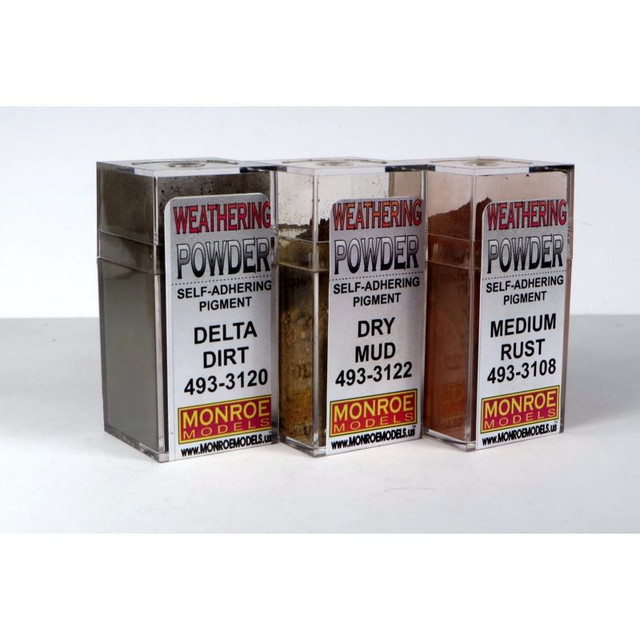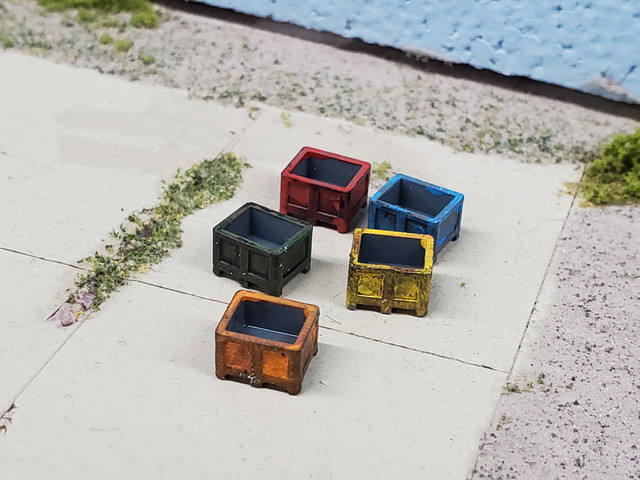Article 4: Weathering Scenery on Your Model Railroad
Introduction to Scenic Weathering
Model railroading is a beloved hobby that allows enthusiasts to create miniature worlds filled with intricate details. To truly capture the essence of real-world landscapes and settings, many model railroaders turn to scenic weathering. This process involves enhancing the appearance of your model railroad scenery by mimicking the natural effects of weather and time. In this article, we will explore the art of scenic weathering, from its importance in enhancing realism to safety considerations and the practical steps involved.
Cleaning and Priming the Base
Before you can embark on the exciting process of weathering your model railroad scenery, it's essential to start with a clean slate, or in this case, a clean base. Properly preparing your base materials is the foundation for a successful weathering project. This section will guide you through the key steps of cleaning and priming your base, ensuring that the weathering techniques you apply will adhere properly and create a convincing effect.
Choosing Suitable Scenic Materials
Selecting the right materials for your model railroad base is a pivotal decision. These materials are the canvas upon which you'll apply your weathering artistry. When choosing scenic materials, consider the following factors to ensure they are compatible with the techniques you intend to use:
1. Durability:
- Your scenic materials should be sturdy and able to withstand the application of weathering products. Ensure they won't deteriorate or warp under the influence of liquids, paints, or other weathering agents.
2. Scale-Appropriate Textures:
- Opt for materials that mimic the textures and scales present in the real world. Depending on the scale of your model railroad (HO scale, N scale, etc.), you'll need materials that look convincing when viewed from a normal viewing distance.
3. Compatibility with Your Chosen Weathering Techniques:
- Different weathering techniques may require specific materials. For instance, some weathering products work better on wood, while others may be more suited for plastics or metals. Ensure that your chosen materials are compatible with the techniques you plan to use.
Techniques for Weathering Scenery
Once you have the right base materials in place, you can begin the exciting process of weathering your model railroad scenery. The choice of weathering techniques depends on the specific effects you want to achieve and the materials you are working with. Here are some common techniques that you can consider:
1. Dry Brushing:
- Dry brushing involves using a brush with minimal paint or weathering powder to lightly coat raised surfaces. This technique highlights texture and simulates wear and tear.
2. Washes:
- Washes are thin, diluted paints or weathering solutions that are applied to the surface and allowed to flow into crevices and recesses. They create depth and accentuate details.
3. Airbrushing:
- An airbrush allows for precise application of weathering solutions. It's especially useful for larger surfaces or creating subtle gradient effects.
4. Weathering Powders:
- Weathering powders can be applied with a brush or sponge to simulate rust, dirt, or other natural weathering effects.
5. Chalks and Pastels:
- Chalks and pastels can be ground into a fine powder and applied to your scenery elements. They are great for achieving dusty or weathered effects.
6. Wash and Dry Techniques:
- This involves applying a wash, letting it dry, and then selectively removing some of the excess to create specific weathering patterns.
By selecting the right materials and employing the appropriate weathering techniques, you can transform your base elements into realistic, weathered scenery that captures the essence of the real world. Keep in mind that practice makes perfect, and experimentation with different materials and techniques will help you refine your skills and achieve the desired level of authenticity in your model railroad scenery.
Adding Realism to Structures and Features
Model railroaders are passionate about capturing the authenticity of real-world landscapes in their miniature worlds. To achieve this level of realism, meticulous attention to detail is essential. In this article, we'll explore how to add realism to the structures and features on your model railroad layout, with a focus on weathering bridges and tunnels, as well as weathering roads and infrastructure.
Weathering Bridges and Tunnels
Bridges and tunnels are iconic elements on any model railroad layout. To enhance the authenticity of these structures, weathering is a valuable technique. Here are some tips for weathering bridges and tunnels:
1. Rust and Corrosion:
- To simulate the effects of weather and age, apply rust and corrosion effects to the metal components of your bridges. Use rust-colored paints or weathering powders. Concentrate the rust in areas that would naturally collect moisture.
2. Dirt and Grime:
- Bridges and tunnels are exposed to the elements and can accumulate dirt and grime over time. Apply washes of earth-toned paint to create a dirty, weathered appearance.
3. Vegetation:
- Model bridges and tunnels often feature small nooks and crannies that are perfect for growing moss and lichen. Glue tiny pieces of foliage to create the illusion of nature reclaiming the structure.
4. Fading Paint:
- Real-world structures often have faded or chipped paint. Mimic this effect by lightly dry brushing the surface with a slightly different shade, such as a lighter or darker version of the original color.
Weathering Roads and Infrastructure
Roads, tracks, and infrastructure are essential components of your model railroad landscape. They are subjected to daily wear and tear, making them ideal candidates for weathering to achieve a more realistic look.
1. Asphalt and Concrete Roads:
- Weathering asphalt and concrete roads can be done using airbrushing techniques, creating subtle stains and tire marks. You can also use chalk or pastels to mimic oil and dirt stains near intersections and parking areas.
2. Railroad Tracks:
- Weathering tracks involves adding rust, dirt, and grease stains. Apply rust-colored paints or powders to the rails and use washes to create the look of accumulated grime around rail joints and switches.
3. Infrastructure Weathering:
- Weathering infrastructure elements like signal boxes, utility poles, and streetlights can add an extra layer of authenticity to your model landscape. Simulate peeling paint, rust, and dirt, as well as subtle graffiti if appropriate for your era.
4. Weathered Vehicles:
- Don't forget to weather any vehicles on your roads or tracks. Adding dust, dirt, and rust to the wheels and undersides of cars and trains can make a significant difference in your model's overall realism.
Adding realism to structures and features on your model railroad is an art that requires patience and attention to detail. By employing weathering techniques such as rust and corrosion effects, dirt and grime application, and the simulation of faded paint, you can bring your bridges and tunnels to life. Similarly, for roads and infrastructure, consider replicating the wear and tear that they endure in the real world to create a captivating and true-to-life model railroad landscape. Ultimately, the key to success lies in the careful balance of creativity and a commitment to achieving authenticity.
Final Touches and Integration
As you approach the final stages of completing your model railroad layout, the magic truly happens when you blend the weathered scenery elements together and take care of the finishing touches. Additionally, it's crucial to understand how to maintain and preserve your masterpiece for lasting enjoyment.
Blending Weathered Scenery Elements
Blending weathered elements ensures a harmonious and cohesive appearance for your entire layout. To achieve this, consider the following:
1. Color Consistency:
- Make sure the colors of the weathered elements match the overall theme of your layout. This consistency creates a unified and realistic look.
2. Transition Zones:
- Pay attention to transition areas between different scenic elements, such as where roads meet bridges or water features. Blend the weathering effects gradually to create a seamless flow.
3. Weathered Structures:
- Structures and features should complement the surrounding scenery. If you've weathered your bridges, ensure they fit cohesively within the landscape.
4. Vegetation Placement:
- Use weathered elements to your advantage when placing vegetation. Moss and lichen can be strategically added to create a more organic look, especially on structures and rocks.
Maintenance and Preservation
Once your model railroad layout is a work of art, it's crucial to maintain and preserve it for long-lasting enjoyment. Here are some maintenance and preservation tips:
1. Regular Cleaning:
- Dust and dirt can accumulate over time, affecting the appearance of your weathered scenery. Gently clean your layout using a soft brush or compressed air to remove debris.
2. Protective Coverings:
- Consider using clear acrylic covers to protect your layout from dust, moisture, and accidental damage. These covers keep your masterpiece in pristine condition.
3. Inspection and Repair:
- Periodically inspect your layout for any signs of wear and tear, including loose elements or fading weathering effects. Make necessary repairs to maintain the model's realism.
4. Controlled Environment:
- Store your model railroad in a controlled environment with stable humidity and temperature levels. This helps prevent warping or deterioration of scenic elements.
5. Proper Lighting:
- Use lighting that accentuates the weathering and details of your model. Avoid harsh lighting that may cause fading or glare.
6. Protective Handling:
- Be cautious when handling your model railroad to avoid damaging delicate scenery elements or disrupting the weathering effects.
In conclusion, the final touches and integration of weathered scenery elements are vital to achieving a stunning, true-to-life model railroad layout. The art of blending these elements together seamlessly is what sets apart an ordinary layout from an extraordinary one. Moreover, taking the time to maintain and preserve your masterpiece ensures that it will continue to be a source of joy and admiration for years to come. So, embrace the world of model railroading, with its limitless possibilities for creativity and realism, and let your passion for the hobby shine through in your weathered, lifelike landscape. Happy railroading!
Cover Photo from Jon Percy's N Scale layout taken by Jason Stiles
Recent Posts
-
Prototype Spotlight: GE ES44AC — Modeling a Modern Freight Workhorse
Prototype Spotlight: GE ES44AC — Modeling a Modern Freight Workhorse Published 2025-09-29• 8–10 min
-
How to Build a Realistic Freight Yard: Flow, Trackwork, and Car Management
How to Build a Realistic Freight Yard: Flow, Trackwork, and Car Management Published 2025-09-25 • 8
-
Scenery Basics: From Foam to Foliage — A Quick, Budget-Friendly Guide | Midwest Model Railroad
Modeling Tutorial Scenery Basics: From Foam to Foliage Published 2025-09-23 · 7–9 minute read Li






